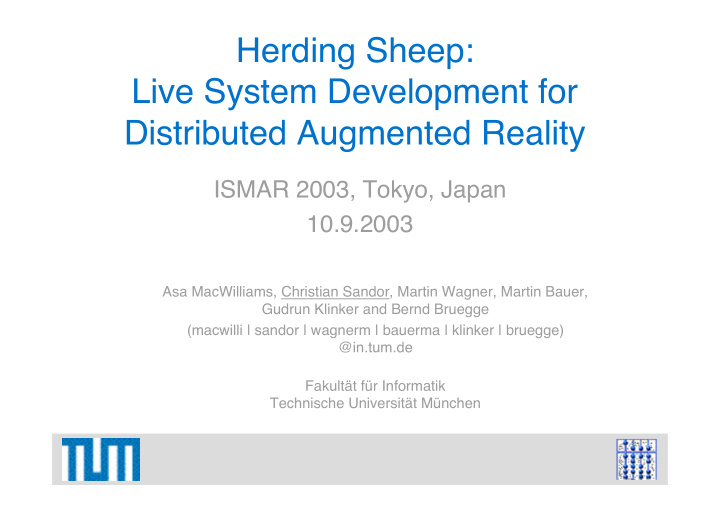



Herding Sheep: Live System Development for Distributed Augmented Reality ISMAR 2003, Tokyo, Japan 10.9.2003 Asa MacWilliams, Christian Sandor, Martin Wagner, Martin Bauer, Gudrun Klinker and Bernd Bruegge (macwilli | sandor | wagnerm | bauerma | klinker | bruegge) @in.tum.de Fakultät für Informatik Technische Universität München
Introduction • More and more AR systems are built using frameworks: – Repo-3D, Studierstube, Tinmith, MR Platform ... • DWARF framework is unique regarding: – Flexibility at runtime – Distribution among different hosts/operating systems – Introspection facilities – Easy adaption of third-party software • What is SHEEP? – The „Shared Enviroment Entertainment Pasture“ – Distributed multiplayer game with variety of multimodal interactions • Why SHEEP? – AR games are not new: Cow Painting, ARQuake, AquaGauntlet ... – Evaluation and refinement of architectural claims – Testdrive for new development process Christian Sandor Herding Sheep (sandor@in.tum.de) ISMAR 2003, Tokyo, Japan
Outline • The Game – Shows the game from the user‘s perspective • Framework Level – System Architecture – Subsystem Details • Process Level – Methodology – Tools • Conclusion Christian Sandor Herding Sheep (sandor@in.tum.de) ISMAR 2003, Tokyo, Japan
The Game Landscape containing virtual sheep is projected onto a table Christian Sandor Herding Sheep (sandor@in.tum.de) ISMAR 2003, Tokyo, Japan
The Game Players have a variety of devices for interaction Christian Sandor Herding Sheep (sandor@in.tum.de) ISMAR 2003, Tokyo, Japan
The Game A tangible plastic sheep attracts the virtual sheep Christian Sandor Herding Sheep (sandor@in.tum.de) ISMAR 2003, Tokyo, Japan
The Game Point-and-Speak is used to create and remove sheep Christian Sandor Herding Sheep (sandor@in.tum.de) ISMAR 2003, Tokyo, Japan
The Game Sheep can be scooped and dropped with an iPAQ Christian Sandor Herding Sheep (sandor@in.tum.de) ISMAR 2003, Tokyo, Japan
The Game A tracked laptop as window to the virtual world Christian Sandor Herding Sheep (sandor@in.tum.de) ISMAR 2003, Tokyo, Japan
The Game Color of sheep can be changed by user wearing an HMD Christian Sandor Herding Sheep (sandor@in.tum.de) ISMAR 2003, Tokyo, Japan
System Architecture (1) - Subsystems Christian Sandor Herding Sheep (sandor@in.tum.de) ISMAR 2003, Tokyo, Japan
System Architecture (2) - Deployment Christian Sandor Herding Sheep (sandor@in.tum.de) ISMAR 2003, Tokyo, Japan
Subsystem Details (1) • Sheep Simulation – Based on distributed variant of flock of birds algorithm [Reynolds 1987] • Tracking – Dtrack system (ART GmbH) delivers raw pose data – Pipe-filter tracking architecture using DWARF event bus – Calibration component unifies coordinate systems, one-step calibration using a pointing device Christian Sandor Herding Sheep (sandor@in.tum.de) ISMAR 2003, Tokyo, Japan
Subsystem Details (2) - Visualization • VRML browsers with DWARF/EAI adapter • Two types of browsers: – Windows/Intel: Cortona from Parallelgraphics – Linux/StrongARM: FreeWRL • Distributed Scenegraph realized through manual synchronization • Problematic limitations of: – OpenGL/Java on iPAQ – EAI Christian Sandor Herding Sheep (sandor@in.tum.de) ISMAR 2003, Tokyo, Japan
Subsystem Details (3) - Interactions • User Interface Controller: Conversion of multimodal input into commands • Internal structure: Petri-Net – Graphical output during runtime – Based on Petri-net framework jfern (XML and Java) Christian Sandor Herding Sheep (sandor@in.tum.de) ISMAR 2003, Tokyo, Japan
Development Methodology • Incremental development of running system • Continuous integration of evolving components • System design during implementation • Jam Sessions: Interaction design and evaluation during runtime Christian Sandor Herding Sheep (sandor@in.tum.de) ISMAR 2003, Tokyo, Japan
Supporting Tools • One-step calibration with magic wand • Monitoring: – UI: User Interface Controller – Overall system state • Testing: – Tracker simulation – Component simulation Christian Sandor Herding Sheep (sandor@in.tum.de) ISMAR 2003, Tokyo, Japan
Results • The game: – Shown publicly at various occasions, first at ISMAR 2002 in Darmstadt. – User Feedback • Tangible User Interfaces with magical metaphors are easy to use • Direct interaction with head-fixed widgets is bad • Immediate feedback is important (graphical and acoustical) • The framework: – Overall concepts validated – Single components still need improvement • The process: – Still work in progress – Jam Sessions are fun and productive – Introspection facilities are very useful for debugging Christian Sandor Herding Sheep (sandor@in.tum.de) ISMAR 2003, Tokyo, Japan
Future Work • Game extensions: • Integrate recent DWARF improvements into SHEEP: – Saving sheep from wolf and falling off the table – OpenInventor-based viewer – Landscape manipulations – World model: Consistent data storage • Conduct usability studies: – Better calibration (SPAAM) – Consolidation of metaphors – Middleware: Automatic – Runtime usability evaluation tool component startup – Interaction library for User – Mac OS X/Windows support Interface Controller • Process: – Formalization and thorough evaluation – Further speedup of prototyping with new tools (Python 1 ) 1 Special thanks to Joe Newman (TU Wien) Christian Sandor Herding Sheep (sandor@in.tum.de) ISMAR 2003, Tokyo, Japan
End of Talk • Why not start with DWARF today? • Project homepage http://www.augmentedreality.de • Please ask your questions! � 問をどうぞ � ただし英 � でお � いします。 Christian Sandor Herding Sheep (sandor@in.tum.de) ISMAR 2003, Tokyo, Japan
Recommend
More recommend